So far this year, I’ve caught a few largemouth bass, but none of them were worth bragging about. The biggest bass I ever caught was more than 40 years ago on a small mountain pond in North Carolina. The fish probably weighed 5 pounds or so.
Catch-and-release was not part of my young, boyish mindset back then, but the bass had the last laugh. I put my quarry on a stringer and pushed the stake into the muddy shoreline. Moments later, the sturdy green fish gathered enough strength to pull the stringer out of the muck and swam off—along with two panfish that were destined for the frying pan.
I’ve yearned for redemption ever since that summer day. But I’ve never mustered a big bass on a fly rod. For advice on how to fulfill that quest, I called upon two anglers who have kicked a little bass: Debbie Hanson, a guide, women’s sport fishing advocate and blogger; and Shaw Grigsby, Jr., a professional bass tournament angler. Hanson has caught more bass than I’ve dreamed about, on foot and out of a kayak near her home waters in Fort Myers, Fla. Grigsby, from Gainesville, Fla., has surpassed more than a two million dollars in career earnings with conventional gear, but his true passion is topwater bass on the fly.
The Right Setup
The go-to gear for bass on fly is simple. Hanson generally fishes with a 5-weight rod; Grigsby chooses to go a bit heavier with an 8-weight. He has no problem with using a 5 or 6-weight, but fishes the 8 because of convenience since he often uses the same rod for reds. And the bigger rod allows him to throw bigger bass bugs whereas Hanson has the advantage of fishing for bluegill or bass with the smaller setup.
Technical leaders are not necessary. A sturdy, 25-pound butt section with a 10-12 pound tippet will do the job for medium and small poppers and hold up against most bass. Grigsby, however, prefers to go even heavier and uses a redfish leader with a heavier butt section (30, 40-pound) and 20-pound tippet. This allows him to go toe-to-toe with big fish that make a beeline for the brush.
Both anglers use a weight-forward line, which is pretty standard.
Where to Go
Bass are everywhere. That’s probably an exaggeration, but here in Florida you can find one of the seven native species of bass in just about every pond, lake or river or retention pond, so it’s no surprise that the largemouth bass is Florida’s freshwater state fish. But while Florida may rank among the nation’s most bountiful bass states, it isn’t alone in the availability of bass. Largemouth bass can be found in 49 of 50 states (not in Alaska) and in large numbers in virtually every one.
The bass’ accessibility makes it an easy, fun target, particularly for novice fly fishers. You don’t need a boat. Grab a rod, a few basic flies and go to your closest pond.
Wind is usually not as a big a factor as it is in saltwater. You don’t have to worry about getting jostled on a wide-open flat. Nor do you have to study your tides. Or a hatch for that matter.
There is no need to wait for prime conditions. Bass are not that picky. It’s easy to make time for such a willing sparring partner.
When to Go
In the south and a few other parts of the country, mild weather makes bass a year-round target. But in both the south and more northerly locales, spring is usually the best time because that’s when bass start to make the move to shallow water to spawn. Look for sun-splashed sandy spots near shore for your best-sight fishing opportunities.
Spring water temperatures are not usually an issue for bass, but when the hottest summer weather arrives, fish early or late and target fish near shady cover. Docks, lily pads and trees all provide food and cover and comfort from unseasonably high-water temperatures. There’s no hard-and-fast rule on temperature restrictions, but bass prefer a temps in the 75-85 degree range.
Set your fishing schedule accordingly. In the summer, earlier is better.
What to Use
Hanson and Grigsby both use poppers. The patterns and colors you can choose from are infinite. When in doubt, imitate the available prey such as frogs, crickets, lizards and dragon/damsel flies. The other issue is casting ability, wind and your setup. For instance, you’re not going to be able to throw a deer-hair frog on a 5-weight. You can, however, throw a small popper.
The serious bass angler has multiple setups complemented by versatility in his or her fly box. A crease fly, a gurgler, Clouser, Dahlberg diver, muddler minnow, wooly bugger, EP baitfish, the deer-hair swim frog, R.L. dragon, bunny patterns and the Umpqua damsel fly are all good options.
Fish topwater early and late in low-light situations or during cloudy afternoons; use subsurface patterns during the middle of the day. A weed guard is usually a must. And don’t be afraid to experiment with the size of your flies.
“A lot of people have the notion that the bigger the popper, the bigger the bass and that’s not necessarily the case,” Hanson said.
Grigsby, in fact, has recognized this trend during his practice sessions on the tournament circuit when he will sometimes reach for his fly rod when conventional lures are too big, too noisy.
“A lot of times, with these little tiny baits, the bass just suck them down,” said Grigsby, host of the outdoors show One More Cast. “At times, the little small flies are just deadly.”
The Presentation
This is not trout fishing. There’s no need for the perfect drift after a well-placed puddle cast. Bass, in general, are not that picky. However, you do need to be accurate around structure. Once the fly hits the water, vary your retrieve, particularly if you’re fishing topwater.
“If you’re not getting any hits, experiment with the length of the pause between the pops,” Hanson said. “A lot of times, what I’ve found is, sometimes you get excited and you’re not getting any hits, nine times out of ten, if you slow down the retrieve and the cadence of your strips, you’ll get a hit on the pause.”
Food for thought as I begin the path to redemption.
This story was updated to note that bass are found in 49 of 50 states.




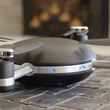
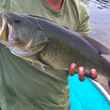





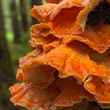




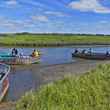



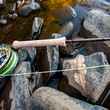




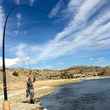


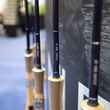
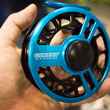
Comments
Robert Best replied on Permalink
I'm going to try to catch a bass on my next trip to the Weeki Wachee in Florida. I have fished black and purple rubber worms with much success over the past 40 years. Can't wait to throw a fly them with my Sage 5wt.
Pages